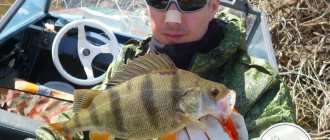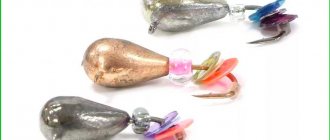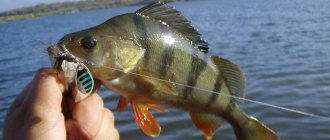Yuri 12/30/2020 274
Currently, fishing enthusiasts can choose any bait. However, it is important to know what season and what fish are suitable for certain species. Among all the options, the carnation lure for perch is the most popular among fans of hunting this predator. With its help you can fish at any time of the year, and the characteristics of the bait allow you to catch fish of any size - from the smallest to the very large. Gvozdik is a type of oscillating spinner. Rings are attached to it, which oscillate when the leash is used and attract the attention of the perch.
You can buy a carnation lure for perch or make it yourself. There are many varieties of bait, so it’s worth studying its features and the intricacies of catching perch with a stud in advance.
Main advantages and disadvantages
This type of bait is different in that it can only be used effectively when catching large predators such as pike perch or pike perch. But even under such conditions, it is very popular among Russian fishermen. When choosing both winter and summer lures, the carnation for perch is the most suitable option due to the following advantages:
- Low cost of the finished product and materials for making it yourself.
- Increases the likelihood of a good catch even during winter fishing.
At the same time, the carnation is an extremely simple design. It got its name because of its behavior on the water. The spinner just stands there like a nail and does not have any special game. It doesn't matter how they throw it. Due to its shape, the stud will always return to the same position.
But this is precisely what attracts perch. He will pay attention to a constantly twitching object in the water and try to attack it. Small individuals are most often frightened by the carnation and swim away from it. Another important advantage is the ability to avoid snags on snags and algae. This allows you to catch bass where they like to be. It has already been proven that the chance of a nail getting caught on a snag is no more than 10%. This characteristic is very much appreciated by domestic fishing enthusiasts.
Types of spinners
Among the wide variety of models, as a rule, there are the most catchy ones, which will be discussed below. This is very important, since it is difficult for a beginner to purchase a productive lure among the huge number of models presented on the store windows. The seller’s task is to sell as much as possible, so he will insist on certain models that few people buy. Another factor that indicates that the types of spinners should be at least a little oriented.
Spinner "carnation"
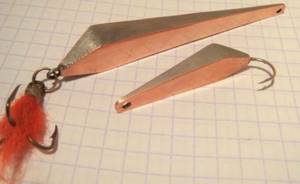
You can catch both small and large perch with such a spoon. It belongs to a number of universal spinners designed to catch perch of any size.
Spinner “three-sided” and “four-sided”

Such spoons are characterized by the presence of a special game due to the design features of the bait. These baits are also called “St. Petersburg” baits. Their game is that the fall of the bait is similar to the fall of a leaf that has come off a branch and moves towards the ground with smooth movements from side to side. Large perch respond well to “three-edges” and “tetrahedrals.”
Spinner "dovetail"

The unusual play of this bait provokes even the most sluggish predator to attack.
The unique shape of the spoon allows it to take a horizontal position and glide to the side. This process occurs quite quickly and abruptly, which does not go unnoticed by the predator.
Moreover, in winter you can catch not only perch, but also other predators, such as pike and pike perch.
Varieties of carnation spinners
All carnation spoons are divided into three categories. Their main difference is the weight of the bait. They can be like this:
- Carnations weighing from 15 to 25 grams. Suitable for catching small predatory fish. However, because of them you should not count on large prey.
- From 25 to 35 gr. The most popular option. Allows you to catch large perches. Due to its size, smaller fish do not respond to the bait.
- More than 35 gr. Such a heavy bait is only suitable for catching especially large perches and even pikes.
Since cloves are a type of oscillating bait, they attract the attention of predators in the water. However, in general, interest in it depends primarily on the time of year (affects the level of activity of perches) and the weight of the bait (the larger it is, the larger the fish it attracts).
As for the influence of the time of year, it is worth remembering that in very cold months, perch prefers to live among snags at the very bottom of the reservoir. In this case, it will be difficult to attract his attention. There are not many ways to do this, and a carnation spoon for perch in winter is the best option. You need to use heavy bait and then you may be able to get a big catch.
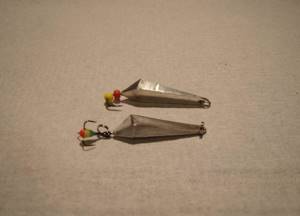
Some difficulties in winter fishing with a carnation may arise for those who have never done it before. In this case, you can practice a little. To do this, you need to take a large glass jar, pour water into it and test the spinner. This will allow you to understand how it will behave in open water.
Due to the popularity of the clove, you can purchase it at any fishing store. However, some people prefer to make their own spinners. There is nothing difficult about this if you have all the necessary materials, free space and tools at hand.
Main characteristics of homemade bait
Unlike pike and pike perch baits of this type, homemade perch spoons have the following characteristics:
- Size – spinners for catching perch have a length from 20 to 40-60 mm.
- Weight – from 2.5 to 5-6 grams;
- The shape is oblong, imitating a small fish (perch, gudgeon, roach, sailor perch);
- Color – for winter fishing for perch, lures with a shiny silver and golden color are suitable;
- Type and method of fastening hooks. In perch baits of this type, both rigid and movable mounts are used for the hooks used. At the same time, spinners with rigidly fixed (soldered) hooks have a more stable game.
Also, perch baits of this type are most often equipped with single or double hooks. Tees are placed on such spoons in those reservoirs where trophy perch are caught.
Misconceptions when creating bait
When making winter perch spoons on their own, many beginners often have the following misconceptions:
- Possibility to use the made bait also in open water. Even the most catchy winter perch spoons are of little use for fishing in summer;
- Using one spoon for all reservoirs. The same bait can behave differently in different water bodies.
Also, beginners often think that the size of the spoon plays a role in its catchability. Like, the larger the spoon, the larger the fish it will take. This statement is true only when the predator is highly active. Usually during periods he is hungry for the first and last ice.
We recommend reading: Do-it-yourself bulldozer tackle
Adviсe
Before making a perch lure, it would be a good idea to listen to the following advice from experienced perch fishermen:
- To increase the attractiveness of a metal fish, multi-colored beads, woolen thread, and cambrics are placed on its double or by hooking a single hook;
- When equipping a metal fish, only sharp, high-quality hooks are used;
- After production, the imitation fry is checked in a barrel or aquarium filled with water;
- Using red waterproof varnish, an attack point is made on the body of the spinner - a small red eye that attracts a predator.
For the convenience of quickly replacing the spoon during fishing, a small clasp is attached to its upper winding ring
Making a carnation spinner for perch with your own hands
Before starting work, it is recommended to prepare all the necessary tools in advance. In the process of making a spinner, you will need pliers, a soldering iron, a small vice, something sharp, sandpaper, metal scissors and wire. Most of these tools are unlikely to be in everyone's home, so it's best to find them in advance. You can also find a sheet of copper, a marker, solder, and a treble hook to make the job easier.
Now you can get to work. The process of making a carnation looks like this:
- The contours of the spoon are drawn on a copper sheet with a marker. At the same time, it is important to maintain the proportions of the bait. This is an important point on which its effectiveness depends.
- Using scissors, the workpiece is cut out.
- The workpiece is clamped in a vice. Use pliers to bend the edges. All surfaces, especially edges, are sanded with sandpaper.
- Fastenings for hooks and other devices are made from wire.
- Now you need to heat the workpiece and make holes in it for the fishing line and fastenings.
- At the last stage, all parts are connected.
In fact, after the first sample, further making with nails will not cause any difficulties. Therefore, many fishermen have several dozen such baits. And all of them can be experienced now. At the same time, you don’t need to freeze on the ice all day. All you have to do is come to the Sazanya Bukhta base. Here all guests are provided with three meals a day and accommodation. You can rent a boat, barbecue or smokehouse and use the services of an experienced huntsman. Good and comfortable fishing in Sazanya Bay is guaranteed, and winter discounts on base services make it now the most affordable.
Winter lures for perch by type
Lures for fishing under ice are divided according to the quality of wiring, game and distribution of the center of gravity into:
- Vertical or bottom. The center of gravity of these is concentrated in the lower part. They play vertically without deviations from the trajectory. When I land, they lift up everything that is at the bottom, thereby attracting additional attention from the predator.
- Gliding, petal-shaped. Due to the configuration, during play they deviate greatly, oscillating, from the center of the hole.
- Loose, or those in which the center of gravity can be redistributed from side to side. They are lowered to the bottom in a horizontal position.
- The step is those baits whose shape is curved, similar to a crescent. The hook is rigidly fixed. The bait moves vertically towards the bottom, reminiscent of descending steps, which is where this species got its name.
Let's look at the main, most popular types of spinners and how to make a spinner for perch.
To work, you should have the following tools: metal scissors, hammer, awl, rasp, sandpaper.
Carnation spinner
This type of bottom spoon for perch with your own hands is one of the most popular. There are a lot of variations in shape. It can be a triangle or an oval. The edges can be either sharp or rounded. The basic idea is that the bait should resemble a small fish. Manufacturers adhere to this principle when making a spinner that looks like a fry.
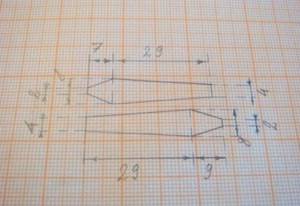
An imitation fish should attract the attention of a predator, so copper and stainless steel are ideal materials for homemade baits.
To make a nail type spinner you will need a sheet of copper, a hook, solder and soldering acid, and wire. A drawing is made on a copper base, according to which two parts are cut out. The wire is used to form a hook attachment, which is soldered to one of the blanks.
The second workpiece is bent and soldered to the first. The resulting voids are filled with solder. Holes are made for the fishing line. The body of the artificial fish is carefully cleaned, acquiring smooth edges. The surface is polished. Now the carnation is ready.

tube
A very catchy bait, easy to make and does not require large material costs. The design is so simple that experienced fishermen stock up on bait in large quantities in case the line breaks, which is not uncommon when catching a predator in snags.

The tubes are divided into:
- Hollow specimens. This design is effective when fishing at depth and in currents, and is very maneuverable when moving sideways.
- Tubes with sealed top. Popular view. When retrieving, the bait may deviate to the side due to the resistance of the water mass. The advantage of the bait is that it plays aggressively, which the perch likes, and its hollow design makes a sound, which is effective in the dead of winter, when the striped hunter is passive. The fish reacts with interest to noise.
- Loaded baits. They are not particularly popular and are used in rare cases when it is necessary to cast bait far away in strong wind conditions. They got their name because part of the tube is filled with metal for weighting.
- Noise tube. Popular model because Perch responds well to noise. Both ends of the tube are sealed. To obtain a noise effect, small balls, such as shot, are placed inside the tube before sealing. I react to the sound the bait makes, and the perch actively attacks.
- Composite spoons, consisting of several parts, usually 3. This type of spoon is very catchy, its movement resembles the movement of a live fish.
A handmade spinner tube made from various tubes. It can be either aluminum or copper. For manufacturing you will need solder, abrasive material, tees, winding rings, fins - stabilizers.
There are no established sizes that show the greatest effectiveness. The size is selected according to weather conditions, time of year, and landscape features of the reservoir. The same length of a product made from different materials that differ in weight will play out differently. The cutting angle of the bait also matters.
It is best to test this type of bait in a real body of water.
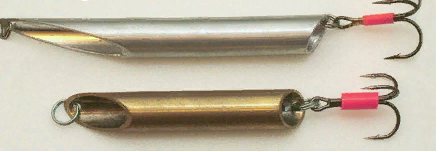
This spinner is very easy to make. A piece 50-90 mm long is cut from a workpiece made of aluminum or other material, 6-9 mm in diameter. The edges are cleaned, a bevel is made on one side and an angle on the other. Holes are made at the edges for attaching the winding ring on one side, and the tee and fin on the other side.

A loaded spoon is made according to the same principle, but only molten lead is poured into the body of the bait either on one side or on both.
There is a noticeable pattern: in winter, when the fish are passive, a shorter tube-type bait is used.
Winter spinner Maropedka
This bait refers to vertical baits. Very catchy and very loved by fishermen.
First of all, an unusual name, Maropedka. Secondly, the simplicity of the design makes it easier to do it yourself. And thirdly, profit is very effective.

The name has its own history, because... its inventors collected in this specimen the characteristics of a diamond, a torpedo and a Matveychikov spinner. Hence the complex name Maropedka. The length of winter specimens is from 30 mm, the wings turn up to 120 degrees. The most effective baits for perch, as well as other types of baits, are 40 mm long. The bend of the wings is optimal at an angle of 90 degrees. The greater the depth, the greater the weight of the bait.
Features of catching perch with a nail
It’s not enough to just make or buy a carnation spoon. You still need to know how to use it correctly. You should play with bait like this:
- First, throw it to the bottom and wait 15 seconds.
- Raise it a little and hold it at this level for a couple more seconds.
- Now you can sharply pull it out to the hole itself.
Such movements attract the attention of the perch, and he will certainly be interested in the bait. In addition, it is important to know the best places to look for perch and when to do so. There's no need to rush here. When going out to catch predators in winter, you need to be on ice at least 8 cm thick. This requirement is due to basic safety rules.
However, it is important to remember when choosing a lure for perch for winter fishing that the clove shows maximum effectiveness at the beginning and end of winter. At the same time, it is important to know and take into account the habits of the striped predator. So, with the onset of the wilderness, large individuals go into hibernation, from which it is almost impossible to bring them out. On very cold winter days, you can only catch big bass if they are hungry and woken up because of it.
A carnation spinner can work in the dead of winter if there are medium-sized perches in the pond. They weigh a lot, but their habits do not differ from young individuals - they gather in flocks of up to 50 animals. Each individual weighs 500 grams or more. Finding such a flock among fishermen is considered real luck. Otherwise, when winter fishing you should count on a small catch of perch weighing no more than 200 grams. To ensure a good catch at the beginning or end of winter, you will have to carefully study the reservoir. To do this, you need to make many holes and check for the presence of perches in different places.
If you want to test the effectiveness of studs in winter perch fishing, you don’t have to freeze at the hole all day. For just 1,500 rubles per day you can come to Sazanya Bay. The price includes accommodation, three meals a day and other services.
TAGS:
Hooks on lures
Depending on the type of spoon, it may have one or more hooks located accordingly. You should pay attention to the spinner:
- with a single, rigidly fixed hook;
- with a double, rigidly fixed hook;
- with a hanging hook on a ring;
- with hanging hook on chain.

Each hook mount has both pros and cons. If you take a single hook, then it does not interfere with the game of the bait. You can always quickly remove caught fish from a single hook without any problems. Most winter fishing enthusiasts prefer just such baits. If the bait has two hooks soldered to it, then it is more difficult to remove fish from two hooks, although they also do not distort the play of the spinner. A hook that can move freely from side to side can harm the game by making some changes. Despite this, the hook, just like the spinner, attracts a predator. If the hook is attached to a chain, the bait begins to work on a completely different principle and it is quite possible that the hook will attract the perch more than the spoon itself.
No matter what game the spinner shows, the attack still falls on the hook, regardless of where in the bait it is attached.
Tags
Carp Buffalo Spring Vobla Asp Winter Crucian Rudd Summer Fishing baits Lower Volga Perch Autumn Fisherman's reminder Lures Bite forecast Fishing in Astrakhan Fishing baits Fishing tackle Fishing secrets Catfish Fishing methods Pike perch Catch Pike
Characteristics of fish
Perch is considered the most striking representative of the ichthyofauna of the central and northern regions of Europe, Asia and North America. Its color is so attractive that only brook trout and grayling can compete with it. In nature, there are two varieties of this fish, which differ only in the color of the body and fins - ordinary perch and American yellow perch. And although both species have practically no differences in appearance, at the genetic level they are not considered relatives.
The fish cannot boast of an impressive body length and heavy weight, since the largest trophy caught weighed about 6 kilograms and had a 50-centimeter body. The average fisherman most often manages to catch individuals of 150-300 grams, the size of a palm. As a rule, they lead a gregarious lifestyle and stay in coastal waters. Larger representatives of the species prefer solitary hunting, so it is quite difficult to catch them.
When choosing catchable lures for perch in winter, you need to understand that they differ significantly from similar baits for other predatory fish. In most cases, these are compact, narrow-bodied products 3-7 centimeters long, which are created on the basis of copper, brass or stainless steel with galvanic coating.
To increase the weight and successfully solder the hook, lead must be attached to one of the surfaces of the spoon. The number of hooks varies from 1 to 3. Some spinners do not have a soldered hook, and instead, a tee or chain with a hook is fixed using a winding ring.

Beautiful play in the water is ensured by the specific shape and bend of the bait. Often, summer spinners with a minimum size and a driven body are used for fishing in winter.


